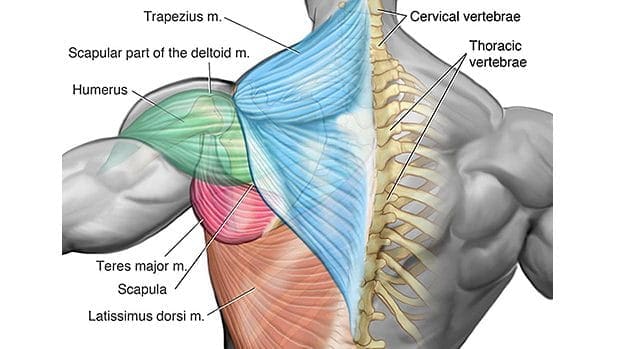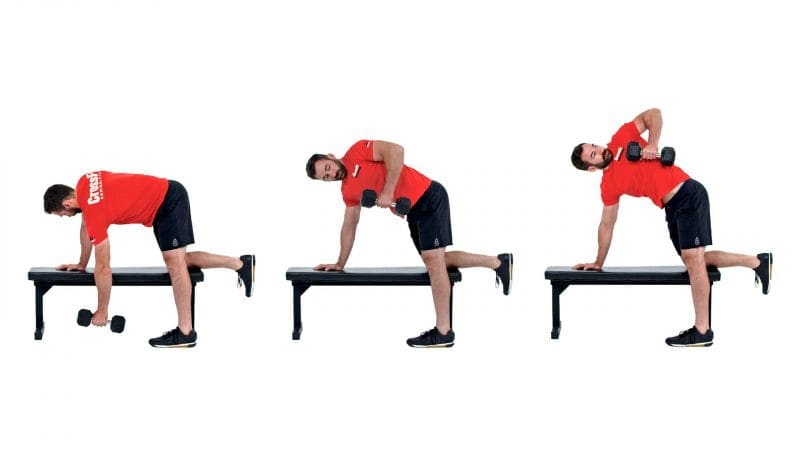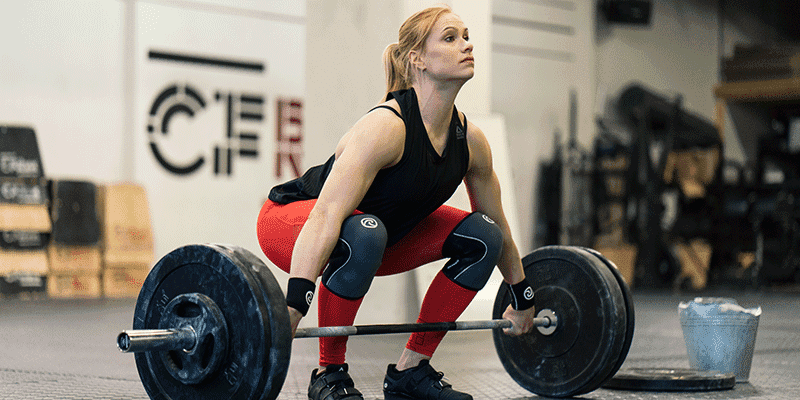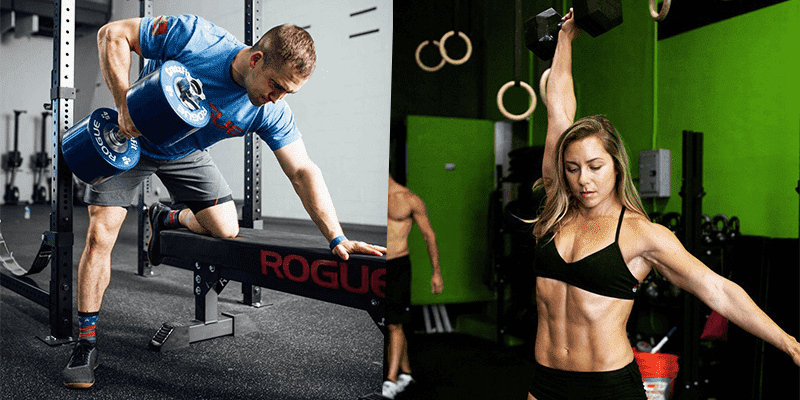The dumbbell row is practical, does not require much space, needs only one piece of equipment, has different variations and can be performed by elite athletes or scaled down to beginners. It is a multifunctional exercise that should be incorporated into anybody’s workout.
As the name suggests, all you need is a dumbbell. You do not even need to own two of them, just one is enough to start mastering this versatile exercise that will build up your back, shoulder and triceps muscles.
In this article, BOXROX will explain everything you need to know about the dumbbell row:
– Variations of the dumbbell row
– Benefits of doing dumbell rows
– Who should add dumbell rows to their workouts?
We have selected 5 CrossFit workouts that include dumbbell rows to get your muscles fired up. You can find them at the end of this article.
Dumbbell Row – Muscles Worked
The dumbbell row primarily hits muscles on your back, but also improves core stability, while engaging muscles on your shoulder, biceps and triceps. The muscles worked are as follow:
- Latissiumus dorsi – the broad muscle along the back of the ribs
- Rhomboids – the smaller upper back muscle
- Trapezius – located across your shoulder blades in the upper back
- Posterior deltoids at the back of the shoulders
- Erector spinae that lie along the spine and the rotator cuff
- Biceps muscles of the upper arm will help with joint stabilization
- Triceps

How To Do a Dumbbell Row
On a bench parallel to you, place a hand and knee of the same side on it, while the other foot is touching the ground. A dumbbell should be on the ground next to the bench and close to your foot. Reach down with your free hand and grab the dumbbell with palms facing you. Remember to keep your back straight at all times – this will engage your core throughout the exercise.
Row the dumbbell to your side by pulling your elbows back towards the hips and upwards. The elbow should barely pass your torso line. Lower the dumbbell until the arm is fully extended. That is one rep.
Variations of The Dumbbell Row
You can change the underhand grip in order to tackle different muscles with this exercise. Palms facing forward, in the same direction as your head, means your biceps will become more active during the row repetition. Palms facing backward will focus on your back muscles.
It is possible to perform the same movement with two dumbbells at a time. In order to do that, keep a natural curvature of your spine (straight back) while you bend over holding one dumbbell in each hand (hammer grip). Perform the row normally and keep the focus on your back not to arch or curve your spine. This is called a bent-over dumbbell row.
You can also add a stability ball to the exercise. You should place your free hand on a stability ball to engage smaller stabilizer muscles from the torso, arms and shoulders.
A powerful variation of the dumbbell row is the dumbbell renegade row. Place two dumbbells on the floor, assume a plank position, feet a bit wider than shoulders, and grasp the dumbbells so your hands are elevated off the floor. Maintain a neutral wrist position (hammer grip) and perform one row on each side while maintaining a stable body (straight flat back). This combines the benefits of a plank and the traditional dumbbell row, which engages your core muscles more than a regular dumbbell row.
Would you like to see other dumbbell shoulder exercises to get a perfect round shoulder? Click here.
Dumbbell Row – Mistakes to Avoid
Do not overload when beginning the exercise. This will strengthen your lats, but could also neglect the smaller stabilizer muscles from your back and especially your core. Start with smaller weights, more reps (15-20) and squeeze the shoulder blades during the movement. Increase the load after completing a couple of sets with a smaller amount of weight.
At all times, you should keep your back straight and not curved. Your head should follow the same direction as your torso, so avoid forward or throwing back the head.

Move the shoulder blades, not the arm. Your shoulder blades should initiate the row movement, not your arms. Also, avoid rotating your body when rowing, as this prevents your scapular muscles to be used. Perform the row movement in a controlled way. Do not create momentum with the entire body by humping and jerking.
Keep your grounded foot lunged back. The foot that is touching the ground should not be close to the hand that will perform the row, as this will minimize the space to do the exercise’s movement. By putting the foot further back, it opens up the lat muscle to work it better.
Benefits of a Dumbbell Row
The dumbbell rows are a unilateral exercise, meaning it remedies strength and muscular asymmetry in either side of the body.
The dumbbell row allows for a great stretch at the midpoint of the repetition, meaning more rapid hypertrophy and muscle growth. It can also improve posture by strengthening the upper back, a muscle that is usually neglected.
It will help you achieve an appealing aesthetic shape. For man, the dumbbell row will strengthen the back and creating the v-shape torso. Women will create a broader back, making the waistline seem thinner, which helps achieve the hourglass shape.

Lower-back-pain-Annie
© RehbandWho Should Add Dumbbell Row To Their Workouts?
The athlete groups who benefit from adding dumbbell rows to their workout routines are powerlifters, Olympic lifters, and CrossFitters.
The dumbbell row strengthens heavily the back muscles, your grip and arms. Powerlifting athletes rely heavily on their back and grip capabilities to perform deadlifts and any other movement that requires the person to squat.

Olympic weightlifters need back muscles to maintain strength and posture over time with heavy loads.
CrossFitters can use the dumbbell row to fix any imbalance strength on the back. It improves the athlete’s performance when doing pull-ups and deadlifts, for example.
Read more: 7 Essential Back Exercises to Build Strength, Muscle and Power for Crossfitters
5 CrossFit Workouts With Dumbbell Row
“(GYM) WOD #126”
2 rounds:
- 2 minutes goblet squats
- 1 minute alternating v-ups
- 2 minutes shoulder presses
- 1 minute sit ups
- 2 minutes lunges
- 1 minute bicycle crunches
- 2 minutes bent over row*
- 1 minute knee tucks
*1 minute per arm
Workout by Heather Black
“190427”
5 rounds for time of:
- 7 left-arm dumbbell rows
- 7 right-arm dumbbell rows
- 21 dumbbell bench presses
- 500-m row
Men: 50-lb. dumbbells
Women: 35-lb. dumbbells
“Swole-Tel”
Four Parts in 12 minutes
EMOM for 3 minutes:
- 15 Dumbbell Rows (2×30 lb)
- 10 Push-Ups
EMOM for 3 minutes:
- 10 Dumbbell Rows (2×40 lb)
- 10 Push-Ups
EMOM for 3 minutes:
- 5 Dumbbell Rows (2×45 lb)
- 10 Push-Ups
Then, AMRAP in 3 minutes:
- Dumbbell Rows (2×30 lb)
Perform the entire workout with a running clock. No rest between sections. Score is the total number of dumbbell rows completed in the final 3-minute AMRAP section of the workout.
This workout utilizes a variation of the dumbbell row described here: the dumbbell bent-over row with one dumbbell in each hand.
Workout by Chase Ingraham
“(GYM) WOD #34”
20 minute AMRAP
- 20 calorie row
- 10 dumbbell burpees
- 20 dumbbell push press
- 10 dumbbell burpees
- 20 dumbbell bent over row
- 10 dumbbell burpees
- 20 push-ups on dumbbells
- 10 dumbbell burpees
The workout does not specify the weight of the dumbbell. It also utilizes a variation of the dumbbell row: the dumbbell bent-over row with one dumbbell in each hand.
Workout by Heather Black
“Stuck At Home”
AMRAP in 10 minutes
- 12 Dumbbell Power Snatches (50/35 lb) (alternating)
- 6 Dumbbell Renegade Rows (2×50/35 lb)
- 12 Dumbbell Power Cleans (2×50/35 lb)
On a 10-minute clock, perform as many rounds and repetitions as possible of the prescribed work in the order written.
Score is the total number of rounds and repetitions completed before the 10-minute clock stops.
Workout by Margaux Alverez
"do it" - Google News
April 14, 2021 at 04:22PM
https://ift.tt/3g9Hkg8
Dumbbell Row: Who Should Do It, Benefits, & Mistakes to Avoid (Plus 5 Workouts) - BOXROX
"do it" - Google News
https://ift.tt/2zLpFrJ
https://ift.tt/3feNbO7
Bagikan Berita Ini















0 Response to "Dumbbell Row: Who Should Do It, Benefits, & Mistakes to Avoid (Plus 5 Workouts) - BOXROX"
Post a Comment